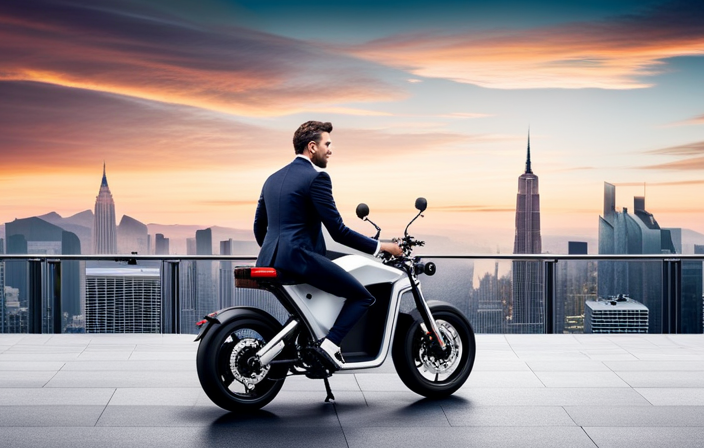Looking to embark on the electrifying journey of converting your bike into an electric powerhouse? Well, hold on tight because we’re about to dive into the nitty-gritty details of finding the perfect bike for your electrification dreams.
In this comprehensive guide, we’ll explore everything from frame compatibility and component evaluation to suspension considerations and conversion costs.
So, gear up and get ready to unlock the full potential of your pedal-powered companion. It’s time to find the holy grail of electric bike conversions!
Key Takeaways
- Consider the compatibility of the bike’s gear system efficiency and ratios with e-bike performance.
- Evaluate the bike’s tire pressure, tread patterns, and width for optimal traction and handling.
- Assess the bike’s frame geometry and suspension for compatibility with the intended riding style.
- Research and choose a conversion kit that suits the bike’s frame and components, and tap into online resources for recommendations and advice.
Understanding Electric Bike Conversions
If you’re considering converting a bike to electric, it’s important to understand the process and requirements. Evaluating conversion kits is a crucial step in this process.
There are various kits available in the market, each offering different features and specifications. When evaluating these kits, it’s essential to consider factors such as motor power, battery capacity, and controller compatibility.
Motor power determines the speed and torque of the electric bike, so it’s crucial to choose a kit that suits your riding needs. Additionally, understanding motor power will help you determine the type of terrain the converted bike can handle.
Once you have a good understanding of the conversion kits, you can move on to choosing the right bike frame, which we’ll discuss in the next section.
Choosing the Right Bike Frame
When choosing the right frame, you’ll want to consider factors such as durability, weight, and compatibility with electric components. Evaluating bike frame materials is crucial, as different materials have varying levels of strength and weight. Aluminum frames are lightweight and affordable, making them a popular choice for electric bike conversions. Steel frames, on the other hand, are heavier but offer superior durability. Carbon fiber frames are lightweight and strong, but they can be quite expensive. Additionally, choosing the right bike size is essential for a comfortable and efficient ride. A frame that is too small or too big can lead to discomfort and poor handling. Take into account your height, leg length, and riding style when selecting the appropriate bike size. Evaluating bike weight and size is crucial for a successful electric bike conversion, as it ensures optimal performance and riding experience.
Evaluating Bike Weight and Size
Considering factors such as durability, weight, and compatibility with electric components is important when evaluating the size and weight of a bike for an optimal riding experience.
Evaluating bike weight and size can greatly impact the overall performance and comfort of an electric bike. A lighter bike will generally provide better maneuverability and ease of handling, especially when navigating through tight spaces or uphill terrains.
Additionally, the size of the bike should be taken into account, ensuring that it fits your body and riding style comfortably.
Determining the bike’s power requirements is also crucial. Electric components such as motors and batteries add weight to the bike, so it’s important to choose a frame that can handle the additional load.
Assessing the bike’s components further enhances the selection process, ensuring that each element works harmoniously to create a powerful and efficient electric bike.
Assessing the Bike’s Components
Assessing the bike’s components is crucial to ensuring a seamless and efficient electric riding experience. When evaluating the bike’s condition, pay close attention to the frame, wheels, brakes, and drivetrain. Look for any signs of wear or damage that could affect the performance of the electric conversion.
It’s also important to consider your budget restrictions when assessing the components. Determine if any parts need to be replaced or upgraded to accommodate the electric conversion without breaking the bank. Remember, a strong and reliable foundation will contribute to a smoother electric ride.
Now that you have evaluated the bike’s components, it’s time to consider the bike’s suspension and how it will impact your electric riding experience.
Considering the Bike’s Suspension
To enhance your riding experience, take into account how the suspension of the bicycle will affect you. The suspension compatibility is crucial when converting a bike to electric, as it determines how well the bike can handle the added weight and power of the electric components.
Consider the following factors when assessing the suspension:
-
Type of suspension: Determine if your bike has a front suspension, rear suspension, or both. This will affect how the bike absorbs shocks and impacts.
-
Suspension adjustments: Check if your bike’s suspension can be adjusted to accommodate the additional weight of the electric conversion. This will ensure a comfortable and smooth ride.
-
Suspension travel: Pay attention to the amount of suspension travel your bike has. More travel can provide better shock absorption, especially if you plan to ride on rough terrains.
Considering these suspension aspects will help you find a bike that is compatible with an electric conversion.
Moving forward, determining battery compatibility is the next crucial step.
Determining Battery Compatibility
Determining battery compatibility is an essential step in ensuring a smooth and efficient electric conversion for your chosen bicycle. When selecting a battery for your electric bike, it is crucial to consider its lifespan and charging options.
Battery lifespan refers to the number of charge cycles a battery can endure before its capacity significantly diminishes. Opting for a high-quality battery with a longer lifespan will save you money in the long run, as you won’t have to replace it as frequently.
Additionally, consider the charging options available for the battery. Some batteries can be charged directly on the bike, while others require removal for charging. Determine which option suits your needs and convenience.
Now, let’s transition into the subsequent section about selecting the right motor for your electric bike.
Selecting the Right Motor
Now that you have determined the battery compatibility for your electric bike conversion, it’s time to focus on selecting the right motor. The motor is a crucial component that will determine the performance and power of your electric bike. When choosing a motor, you need to consider factors such as motor power and battery range. Motor power refers to the amount of power the motor can deliver to the bike’s drivetrain. This determines the speed and acceleration of your electric bike. Battery range, on the other hand, refers to how far your electric bike can travel on a single charge. It’s important to choose a motor that is compatible with your desired motor power and can provide enough power to achieve your desired battery range. Now, let’s move on to analyzing the bike’s braking system.
Analyzing the Bike’s Braking System
When analyzing the braking system of your bike, it’s important to consider factors such as brake type and effectiveness. Evaluating brake performance is crucial in ensuring your safety and the overall performance of your electric bike.
Here are four key aspects to consider when comparing different braking systems:
-
Brake Type: Determine whether your bike has rim brakes, disc brakes, or drum brakes. Each type has its advantages and disadvantages in terms of stopping power, modulation, and maintenance requirements.
-
Brake Pad Material: Different brake pad materials offer varying levels of grip and durability. Organic pads provide better modulation and are quieter, while metallic pads offer superior stopping power but may be noisier.
-
Brake Lever Design: Look for adjustable brake levers that fit your hand comfortably. Ergonomic designs can reduce hand fatigue during long rides and provide better control over braking.
-
Brake Integration: Consider how well the braking system integrates with the electric motor. Some systems offer regenerative braking, which can recharge the battery while slowing down.
As you transition into examining the bike’s gear system, it’s essential to ensure that the braking system is capable of handling the added demands of an electric bike.
Examining the Bike’s Gear System
Examining the bike’s gear system involves evaluating its efficiency and compatibility with the overall performance of the e-bike. One important aspect to consider is the bike gear ratios. These ratios determine the relationship between the number of teeth on the front and rear gears, affecting the bike’s ability to climb hills, accelerate, and maintain speed.
A well-designed gear system will have a wide range of ratios to provide optimal performance in various riding conditions. Additionally, the gear shifting mechanism is crucial in ensuring smooth and precise gear changes. Look for a system that allows for easy and quick shifting, minimizing interruptions in power delivery.
Assessing tire compatibility is the next step in finding the perfect bike for conversion, as the tires need to be able to handle the increased weight and torque of the electric motor.
Assessing Tire Compatibility
Assessing tire compatibility is an essential factor to consider when determining if a bike is suitable for conversion to an e-bike. To ensure a successful conversion, you need to assess tire pressure and choose the right tire type.
Start by checking the tire pressure and ensuring it is within the recommended range for e-bikes. Inadequate tire pressure can affect the bike’s performance, stability, and overall ride quality.
Additionally, the tire type plays a crucial role in determining the bike’s compatibility. Consider the terrain you will be riding on and choose a tire with appropriate tread patterns and width. This will ensure optimal traction and handling, as well as enhance the overall riding experience.
By assessing tire compatibility and making the right choices, you can lay a solid foundation for converting your bike into an electric one.
Now, let’s move on to considering the bike’s riding style.
Considering the Bike’s Riding Style
To determine if a bike is suitable for conversion to an e-bike, it’s important to consider the riding style.
Start by assessing the rider’s preferred riding position. Different bikes have varying riding positions, such as upright, aggressive, or hybrid. This can affect the overall comfort and handling of the e-bike conversion.
Additionally, take into account the terrain compatibility of the bike. Is it designed for off-road adventures, city commuting, or leisurely rides? The bike’s frame geometry, suspension, and tire width should match the intended riding style to ensure optimal performance and safety. A bike with a more aggressive riding position and wider tires would be better suited for off-road trails, while a bike with a more upright position and narrower tires may be ideal for urban commuting.
Now, let’s move on to evaluating the bike’s electrical system.
Evaluating the Bike’s Electrical System
Now, let’s see how well the bike’s electrical system is set up for conversion to an e-bike. Evaluating the bike’s electrical system is crucial in determining its suitability for conversion. One of the key factors to consider is the battery capacity.
A good e-bike requires a battery with sufficient capacity to provide a decent range, allowing you to travel longer distances without running out of power. Additionally, it is important to consider the motor power. The motor should be powerful enough to provide a smooth and efficient ride, especially when going uphill or in challenging terrains. A higher power motor ensures better acceleration and performance.
Evaluating these aspects of the bike’s electrical system will give you a better understanding of its potential for conversion. Moving forward, determining the bike’s conversion cost will help you make informed decisions about the process without breaking the bank.
Determining the Bike’s Conversion Cost
Next, let’s take a look at the cost of converting the bike. Determining the bike’s conversion budget is an important step in the process. You need to consider the cost of the electric conversion kit, which typically includes a motor, battery, controller, and other necessary components.
Additionally, you should factor in any additional parts or accessories you may need, such as a new chain or brakes. It’s also essential to calculate the conversion time, as this will affect the overall cost. Keep in mind that the complexity of the conversion and your level of experience will play a role in how long it takes.
Once you have determined the conversion cost and time, you can make an informed decision about whether to pursue a DIY conversion or seek professional help. Exploring DIY vs. professional conversion is the next step in the process.
Exploring DIY vs. Professional Conversion
When considering converting your bicycle to electric, it’s worth exploring whether a DIY approach or professional conversion would be more suitable. DIY conversion offers numerous benefits, including the ability to customize and personalize your electric bike according to your preferences. It also allows you to gain a better understanding of the technical aspects of the conversion process. However, DIY conversion requires technical skills, time, and access to tools and resources. On the other hand, professional conversion offers several advantages such as expertise, experience, and access to specialized equipment. Professionals can ensure a high-quality conversion, taking into account safety standards and optimal performance. It’s important to weigh the benefits and advantages of both options before making a decision. Moving forward, researching conversion kits and resources will provide valuable insights into the best components and techniques for your conversion project.
Researching Conversion Kits and Resources
To explore conversion kits and resources, you should start researching different options available in the market. When it comes to conversion kit options, there are several factors to consider.
First, you need to determine the type of kit that suits your needs, whether it’s a front wheel, rear wheel, or mid-drive kit. Each type has its own advantages and disadvantages, so it’s important to understand the differences before making a decision.
Additionally, you should look for kits that offer a good balance between power and range, as well as ones that are compatible with your bike’s frame and components.
In your research, don’t forget to check out online forums dedicated to electric bike conversions. These forums are a great resource for finding recommendations, troubleshooting tips, and advice from experienced DIYers. They can also provide valuable insights on the best conversion kits available in the market based on real-world experiences.
By taking the time to thoroughly research conversion kit options and tapping into the knowledge of online forums, you’ll be well-equipped to make an informed decision when converting your bike to electric.
Frequently Asked Questions
Are there any legal requirements or restrictions for converting a bike to electric?
When converting a bike to electric, it’s important to consider the legal requirements and safety precautions.
There may be specific regulations in your area regarding the use of electric bikes on public roads, such as speed limits or age restrictions. It’s crucial to adhere to these laws to ensure your converted electric bike is legal and safe to ride.
Additionally, it’s recommended to take safety precautions such as wearing a helmet, using appropriate lighting, and ensuring the bike is properly maintained.
Can any type of bike be converted to electric, or are there specific types that work best?
When it comes to converting a bike to electric, not all types are created equal. While any bike can technically be converted, certain types work better due to their frame design and compatibility with electric components.
Mountain bikes and hybrid bikes tend to be popular choices for conversions, as they offer sturdy frames and versatile performance.
The electric bike conversion process involves adding a motor, battery, and controller, resulting in numerous benefits such as increased speed, extended range, and a more enjoyable riding experience.
How long does it typically take to convert a bike to electric?
Choosing the right electric bike conversion kit and successfully converting your bike can be a time-consuming process. On average, it typically takes around 4 to 8 hours to convert a bike to electric. However, the duration may vary depending on your technical expertise and the complexity of the conversion kit.
Some common challenges during the conversion process include properly mounting the motor, integrating the battery, and ensuring smooth functionality of the electric components.
Can I still pedal and use the bike as a regular bicycle after it has been converted to electric?
Yes, you can still pedal and use the bike as a regular bicycle after it has been converted to electric. Converting a bike to electric does not completely eliminate the ability to pedal manually. The electric motor simply assists your pedaling, providing an extra boost of power.
However, it’s worth noting that converting a bike to electric does affect its performance and handling. The added weight of the electric components can make the bike feel slightly different to ride, but it shouldn’t significantly impact your ability to pedal and use it as a regular bike.
What is the average lifespan of an electric bike conversion kit?
The lifespan of an electric bike conversion kit can vary depending on several factors. The durability of the kit itself, the quality of its components, and how well it is maintained all play a role.
On average, a well-maintained conversion kit can last for several years. However, factors such as riding conditions, frequency of use, and the weight of the rider can also affect its lifespan.
Regular maintenance and proper care can help prolong the life of the kit.
Conclusion
So, now that you’ve gone through all the steps of understanding electric bike conversions, evaluating various aspects of the bike, and considering the conversion cost, you’re ready to make a decision.
It’s ironic how the perfect bike for conversion may not be the most obvious choice. Picture this – a sleek, lightweight road bike, effortlessly gliding through traffic with the power of an electric motor. It’s like having your own personal superhero vehicle, silently zipping past cars stuck in the never-ending gridlock.
With the right bike and a touch of electric magic, you can transform your daily commute into an exhilarating adventure. Happy riding!









